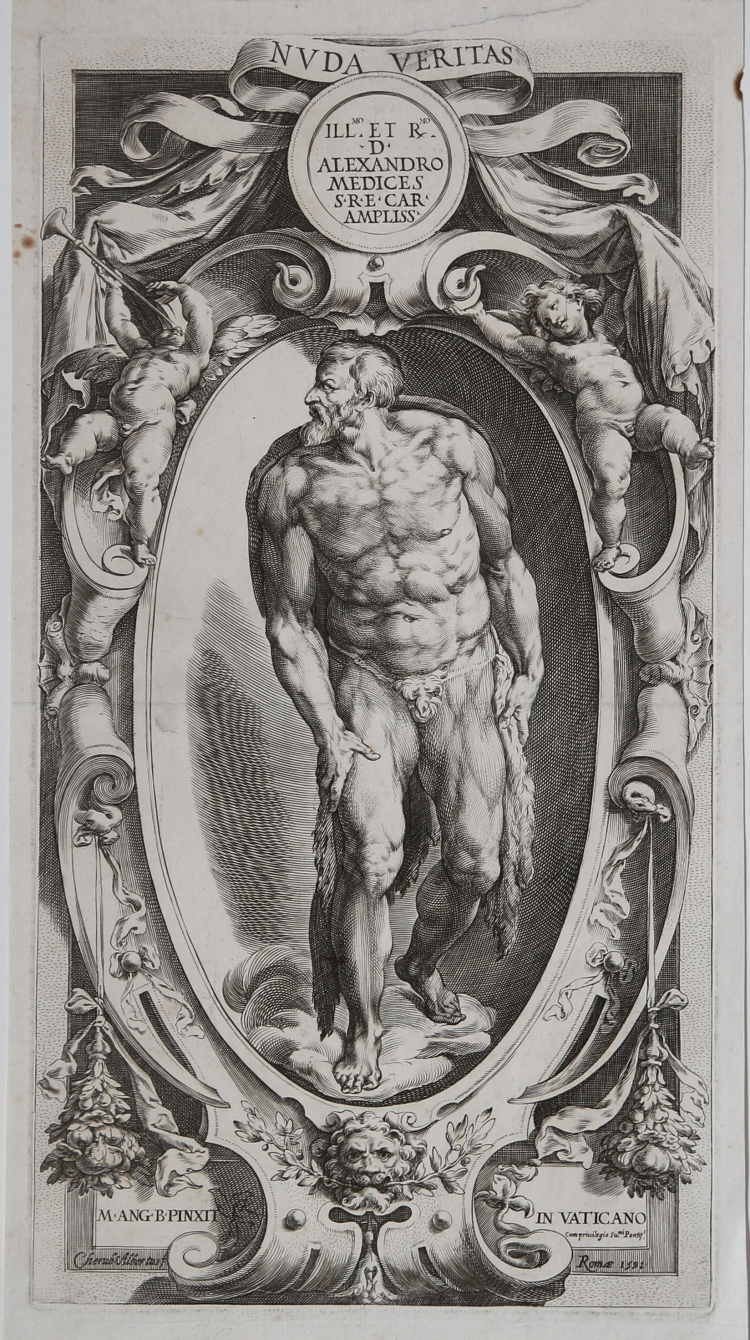



| Reference: | S41925 |
| Author | Cherubino ALBERTI |
| Year: | 1591 |
| Measures: | 234 x 434 mm |


| Reference: | S41925 |
| Author | Cherubino ALBERTI |
| Year: | 1591 |
| Measures: | 234 x 434 mm |
Etching, 1591, along the bottom frame «Cherub.s Albertus.f. Romæ ·1591·»; in the bottom frame "M-ANG-B-PINXIT IN VATICANO"; in the fluttering ribbon at the top now reads "NVDA VERITAS", and inside the circular frame the dedication "ILL.MO ET R.MO / -D- / ALEXANDRO/ MEDICES / S-R-E-CAR- / AMPLISS-".
Exemplae in the fourth final state, where is added under the word "VATICANO" "Cum priuilegio Su.mi Pontif.s". After Michelangelo's 'The Last Judgment' fresco in the Sistine Chapel.
The work was intended by the engraver to form a pair with Petit Aethera like this one dated 1591 and dedicated to Cardinal Alessandro de' Medici.
The two prints are of a very similar format and are the only Sistine engravings by Alberti that are specular with respect to the fresco. Their elaborate frames and dedicatory plaques are signs of their status finished , independent works of art . The phrases , " petit aethera " [ he seeks high heaven ] and " nuda veritas " [the naked truth] , similarly go beyond simple descriptions .
Several authors have pointed to the irony of the inscribed title NudaVeritas since the figure of St. John is here draped. The title requires some comment, for it is inflected not in its classical Horatian sense of candidness or honesty, but rather in its theological sense, as Augustine pronounced in his Divine Institutes: «[biblical] truth is to be more glorious by being plain and unadorned, for it is well enough equipped as it is, and addition of extraneous ornament only masks and corrupts it….». Thus reframed, Cherubino’s print can be seen to embody a more sophisticated and nuanced rejoinder both to Michelangelo’s critics and to the members of the Congregazione who had decided that the Last Judgment needed visual editing. This reading of Nuda Veritas also presupposes an informed and learned viewer, one who was aware of the literary and theological attacks on the Last Judgment and the Congregazione’s response to them.
Cherubino’s decision to dedicate to Cardinal Alessandro the Nuda Veritas and Petit Aethera, which carry the additional inscriptions stating that they were executed “cum privilegii” of the Pope (without documentation),came at a particularly fraught moment during a period of swift turnovers in the papacy following the death of Sixtus V in 1590. Thus, it is difficult to know whether the prints were completed and given privileges during the reigns of Gregory XIV (r. 1591) or Innocent XI (r. 1591-1592). It has been suggested that Cherubino was seeking patronage from the Medici at several key periods in the1590s and early 1600s, which prompts one to hypothesize that Alberti was quite aware of the fact that Alessandro himself might be elected pope The dedications of the two prints to Alessandro are prominently inscribed in a roundel located in the upper register of the cartouche set between two putti.
Nuda Veritas has five small balls – one at top center; two be-low the middle of the cartouche; and the other two at bottom center of the cartouche – that may be a subtle reference to the Medici palle and therefore embody a kind of coat of arms. While my principal argument is here concerned with the artistic response to Michelangelo’s nude figures in the Last Judgment, I do not want to lose sight of the fact that, as Christopher Witcombe contends, Cherubino would certainly have been vying for Medici patronage. His clever and deftly made prints were clearly intended to win not only Cardinal Alessandro’s mind but also his support.
Very good example, printed on laid paper, white margins about 1 cm per side, in excellent condition.
|
A. Alberti, DApres Michelangelo, p. 103, n. 202; Barnes, p. 194, n. 63; Le Blanc I, p. 9; TIB 34, p. 187, n. 67; P. M. Lukehart, Nuda Veritas…, in “After 1564 Michelangelo’s Legacy…, pp. 37 - 55.
|
Cherubino ALBERTI Borgo San Sepolcro 1553 - Roma 1615
|
Engraver, painter and constructor of crossbows, from Borgo San Sepolcro. Active in San Sepolcro
and Rome. Record of death 18 October 1615.
The earliest dated engravings are of 1571.The bulk of his engraved work was produced between 1571 and 1590. Mythological,devotional and ornamental subject ;portraits and antiquities. Prints after Raphael,Michelangelo,Polidoro da Caravaggio,Andrea del Sarto, Rosso Fiorentino, Taddeo and Federico Zuccaro. He kept control of the majorityof his plates and was responsible for publishing them. After his death his heirs reissued many of them, with a privilege of Pope Urban VIII.
|
|
A. Alberti, DApres Michelangelo, p. 103, n. 202; Barnes, p. 194, n. 63; Le Blanc I, p. 9; TIB 34, p. 187, n. 67; P. M. Lukehart, Nuda Veritas…, in “After 1564 Michelangelo’s Legacy…, pp. 37 - 55.
|
Cherubino ALBERTI Borgo San Sepolcro 1553 - Roma 1615
|
Engraver, painter and constructor of crossbows, from Borgo San Sepolcro. Active in San Sepolcro
and Rome. Record of death 18 October 1615.
The earliest dated engravings are of 1571.The bulk of his engraved work was produced between 1571 and 1590. Mythological,devotional and ornamental subject ;portraits and antiquities. Prints after Raphael,Michelangelo,Polidoro da Caravaggio,Andrea del Sarto, Rosso Fiorentino, Taddeo and Federico Zuccaro. He kept control of the majorityof his plates and was responsible for publishing them. After his death his heirs reissued many of them, with a privilege of Pope Urban VIII.
|